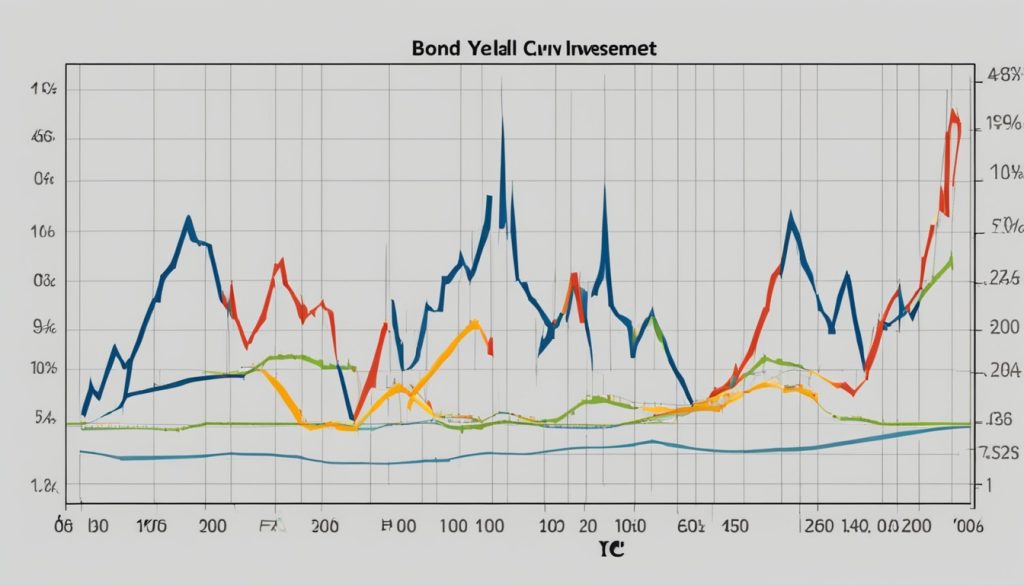Investing in callable bonds can seem tough. But, learning about1 yield to first call (YTC) can help you. It’s a key way to see how much you might earn and spot risks in your financial plans. YTC looks at the possible return if the issuer calls back the bond1. It considers things like interest rates, credit scores, call details, and when the bond can be called1.
We’ll explore why YTC analysis matters, how to calculate it, and what affects it. By understanding yield to first call, you can make better investment choices. This will help you improve your portfolio’s performance in the changing financial world.
Key Takeaways
- Yield to first call (YTC) gives a full picture of what you might earn from a callable bond.
- YTC looks at things like interest rates, credit scores, call details, and when it can be called.
- Knowing YTC is key for handling risks and making smart investment choices.
- Higher interest rates usually mean lower yield to call, as the issuer is less likely to call the bond.
- Bonds with lower call prices or early call dates have higher yields to call, offering more chance for early redemption.
Introduction to Yield to Call Analysis
When you invest in bonds, knowing about yield to call is key. This concept helps investors see how much they might earn from their bond investments. It’s especially useful when the bond can be called back early2. This analysis helps investors understand the risks and rewards of callable bonds. It helps them make better choices and manage their money well.
Significance of Yield to Call Analysis
Yield to call analysis is vital for checking how well callable bonds perform. It figures out the return an investor would get if the bond were called early, not at the end2. This is crucial for investors with callable bonds. If the issuer calls the bond, it can change the investment’s return a lot.
Calculation Methods
There are different ways to figure out a bond’s yield to call, based on its cash flow. The most common method is the yield to call formula. This formula looks at the bond’s market price, coupon rate, call price, call date, and time left until it matures2. Investors can use financial calculators or special software for accurate calculations.
Factors Influencing Yield to Call
Many things affect a bond’s yield to call, like market interest rates, credit ratings, call features, and time to call234. Market interest rates are key because they change the cost savings for the issuer if they call the bond early. Credit ratings matter too, with higher ratings meaning lower yields because they’re less likely to default. The bond’s call features, like the call price and date, also play a big role in the yield to call.
| Metric | Value |
|---|---|
| Coupon Rate | 5%4 |
| Face Value | $1,0004 |
| Call Price | $1,0504 |
| Yield to Call | 4.5%4 |
This example shows a bond with a 5% coupon rate, a $1,000 face value, and a call price of $1,050. The yield to call is 4.5%4.
Knowing what affects yield to call helps investors make smarter choices about their bond investments. This way, they can better manage their portfolios.
Understanding Yield to Call
Yield to Call (YTC) is key for investors looking at callable bonds. It’s the return an investor can get if they hold a bond until it can be called early, not until it matures5. Knowing YTC helps investors see the risks and rewards of callable bonds. This knowledge helps them make better investment choices6.
What is Yield to Call?
Yield to Call is the return an investor can expect if a callable bond is called early. It looks at the bond’s market price, coupon rate, call price, and time until call7. To figure out YTC, you need a complex formula that looks at the bond’s cash flows and the chance of early call5.
Importance of Yield to Call for Investors
Investors use YTC to see the risk and reward of callable bonds. When interest rates go down, companies might call high-rate bonds and issue new ones at lower rates5. Knowing YTC helps investors understand how interest rate changes could affect their investments. They can see if the current yield is enough to cover the risk of early call6.
Calculation of Yield to Call
To calculate YTC, you need to think about the bond’s coupon rate, time until call, and market price7. Investors can use calculators or special software to get an accurate YTC. This helps them understand the info from financial institutions and make better investment choices5.
Yield to Call vs. Yield to Maturity
YTC and Yield to Maturity (YTM) are different. YTM assumes the bond is held until it matures, while YTC considers early redemption6. Looking at YTC and YTM together gives investors useful insights. If YTC is lower, the bond might be called, leading to reinvestment risk. If YTC is higher, there’s a chance for higher returns if called early7.
Example Illustration
Let’s say a callable bond has a par value of $1,000, a 5% coupon rate, and a call price of $1,050, callable in three years. If its market price is $1,020, the YTC calculation would use these details to give investors a realistic yield if called5. This example shows how YTC changes with market conditions and issuer decisions, highlighting the changing nature of callable bonds7.

Understanding Yield to Call helps investors make better decisions on their bond investments. It helps them manage the risks of callable bonds6.
Factors Affecting Yield to First Call
The yield to first call is a key metric for bond investors. It shows the potential risks and rewards of bond investments. Knowing what affects it is crucial for making smart investment choices.
Market interest rates are a big factor. When rates go down, the yield to call goes up. This happens because companies can refinance at lower rates, making bonds more valuable for investors8.
The call premium is also important. It’s the extra cost for a company to call a bond early. A higher premium means a higher return for investors but makes early redemption less likely8.
The bond’s credit rating matters too. Bonds with high ratings have lower yields because they’re less likely to default. But, bonds with lower ratings offer higher yields to make up for the risk8.
| Factors | Impact on Yield to First Call |
|---|---|
| Declining Market Interest Rates | Increases yield to call |
| Higher Call Premium | Increases yield to call, but makes call less likely |
| Higher Bond Credit Rating | Decreases yield to call |
Understanding these factors helps bond investors make better choices. It helps them manage risks in their bond portfolios.
“Yield to call is a vital metric for bond investors, as it helps them navigate the complex landscape of callable bonds and make informed decisions about their investments.”
In summary, the yield to first call depends on market rates, call premium, and bond quality. Keeping an eye on these can help investors improve their bond strategies and reduce risks89.
yield to first call: Evaluating Bond Investment Options
Understanding yield to first call is key for smart bond investment choices. Yield to call (YTC) is the return if the issuer calls the bond early. It can be different from the yield to maturity (YTM) because of fees and shorter time held10.
As a bond gets close to its first call date, the YTC goes down. This is because call premiums decrease, with the biggest fees early on and none in the last year10. For example, a discount bond might have a YTC of 8.7%, higher than its YTM of 6.4%, because of these fees10.
Knowing how YTC and YTM relate helps investors see the risks and rewards of different bonds. Looking at different yield metrics, like current yield and YTW, shows the possible returns and risks11.
Companies also find YTC important. It helps them decide on refinancing, balancing new bond rates with current ones10. Companies use YTC to see the pros and cons of refinancing and set expectations for new bonds, affecting investor views and coupon rates10.
| Yield Metric | Definition |
|---|---|
| Current Yield | The annual coupon interest divided by the market price of a bond, allowing for simple comparison based on the purchase price11. |
| Yield to Maturity (YTM) | The discount rate that equates the present value of a bond’s future cash flows to its market price, accounting for the time value of money and reinvestment of interest11. |
| Yield to Call (YTC) | The return calculated assuming the bond is called on its first call date, considering the callability of bonds and their embedded optionality11. |
| Yield to Worst (YTW) | The lowest yield possible by considering various call, put, and maturity scenarios, offering a conservative rate of return estimation for investors11. |
Bonds include corporate bonds, municipal bonds, and U.S. Treasuries and are key in many portfolios12. Knowing about different yield metrics is key for picking and managing bond investments1112.

Watching the yield curve and YTC and YTM relationship helps investors make better bond investment choices. Always talk to a financial advisor for advice on bonds that fit your financial goals and risk level121011.
Interpreting Yield to Call Results
Looking at yield to call (YTC) reports is key for investors to make smart bond investment decisions13. YTC shows what returns an investor might get if a bond is called early, which can cut the return due to early redemption13. Bonds that can be called often have higher yields because the issuer can refinance at lower rates if rates drop13.
To figure out YTC, use this formula: YTC = (Coupon Interest Payment + (Call Price – Market Value) ÷ Number of Years Until Call) ÷ ((Call Price + Market Value) ÷ 2)13. For instance, a bond with a $10,000 face value, 7% coupon, 5 years to call, and a current price of $9,000 would have a YTC of 5.4%13. But, online calculators might not give the right YTC numbers13.
Assessing Reinvestment Risk
Looking at YTC also shows the risk of reinvestment risk. If YTC is less than the yield to maturity (YTM), the bond might be called, forcing investors to reinvest at lower rates13. Knowing this risk helps investors manage their risk and adjust their portfolios as needed.
Comparing Yield to Call Across Bonds
Comparing YTC across different bonds gives investors important insights14. By looking at YTC for various bonds, investors can see their value and risk levels14. This helps investors pick bonds with high potential returns if called and those at higher reinvestment risk. This way, they can build a diverse and optimized portfolio.
Understanding YTC is key for investors using bonds in their financial plans13. By analyzing YTC reports, looking at reinvestment risk, and comparing YTC across bonds, investors can make better investment decisions. This helps them handle the risks of callable bonds13.
“Yield to worst” is the best way to evaluate bonds, using the lowest possible yield. It compares yield to call and yield to maturity to find the safest estimate13.
Conclusion
Understanding yield to first call is key for investors looking at bond investment options, especially for callable bonds15. By looking at what affects yield to call, figuring out the numbers, and comparing different bonds, you can make smarter choices. This helps you manage risks and aim for your financial goals15.
Yield to call is the expected return if the bond is called early15. It’s a complex calculation that includes the bond’s price, coupon rate, time until call, and call price15. Knowing and analyzing this can help you see the possible early return on your investment15. Metrics like yield to maturity, current yield, and duration also give you more info to check your bond investments15.
Yield to first call is a great way to handle risk and improve your portfolio. By getting this concept and using it in your investment plans, you can make better choices. This boosts your chances of reaching your financial goals1516.
FAQ
What is Yield to Call (YTC)?
Yield to Call (YTC) is the expected return on a bond until it can be called. It’s what an investor can earn if the bond issuer calls it early. YTC includes the bond’s market price, par value, coupon rate, and time until call.
Why is understanding Yield to Call important for investors?
It’s key for investors looking at callable bonds. YTC shows the possible return if the issuer calls the bond early. This helps investors weigh the risks and rewards of different bonds.
How is Yield to Call calculated?
Calculating YTC is complex, involving the bond’s cash flows, call price, and time to call. Investors use calculators or software for accurate calculations.
What is the difference between Yield to Call (YTC) and Yield to Maturity (YTM)?
YTM assumes the bond is held till maturity. YTC considers early redemption. Comparing these values shows insights. A lower YTC than YTM means the bond might be called, leading to reinvestment risk. A higher YTC means a better return if called early.
What factors influence the Yield to First Call?
Factors like market rates, call premium, and bond quality affect Yield to First Call. Falling market rates increase the yield to call, making refinancing at lower rates more attractive. The call premium and bond quality also play a role.
How can investors interpret Yield to Call results?
Understanding Yield to Call helps investors make better decisions. It shows the potential early return on bonds. By analyzing the calculation and its factors, investors can compare different bonds’ values and risks.
Source Links
- Yield to Call Analysis: Evaluating Investment Options – FasterCapital
- Introduction to Fixed Income Valuation
- Callable Bonds: Understanding How They Work
- Yield to Call Calculation: A Step by Step Guide – FasterCapital
- Yield to Maturity vs. Yield to Call: What’s the Difference?
- What Is Yield To Call? Definition and How It’s Calculated
- Yield to Call (YTC)
- Understanding Bond Yield and Return
- Yield | Bond fundamentals | Achievable Series 7
- Yield to Call: Formula, Meaning, and Excel Examples
- Master Class: Bond Yields
- What Bond Investors Need to Know About Yield
- Learn the Difference Between Yield to Call and Yield to Worst
- The Basics on Callable Bonds and Yield-to-Call
- Yield to Call: Calling All Investors: Understanding Yield to Call Basis – FasterCapital
- Bond Yield

